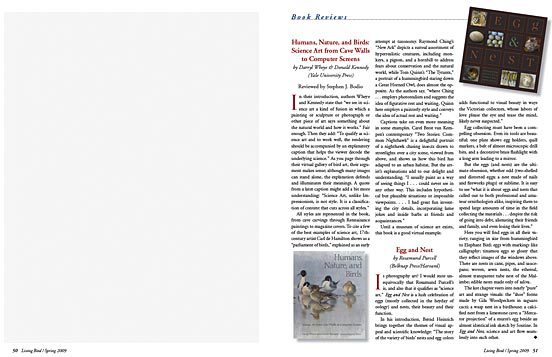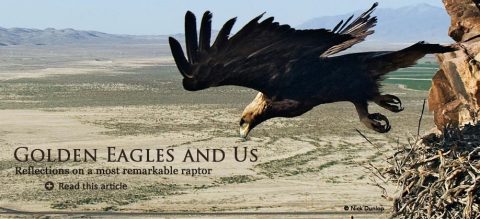Book Review: Humans, Nature, and Birds, by Darryl Wheye
Reviewed by Stephen J. Bodio April 15, 2009
In their introduction, authors Wheye and Kennedy state that “we see in science art a kind of fusion in which a painting or sculpture or photograph or other piece of art says something about the natural world and how it works.” Fair enough. Then they add: “To qualify as science art and to work well, the rendering should be accompanied by an explanatory caption that helps the viewer decode the underlying science.” As you page through their virtual gallery of bird art, their argument makes sense; although many images can stand alone, the explanation defends and illuminates their meanings. A quote from a later caption might add a bit more understanding: “Science Art, unlike Impressionism, is not style. It is a classification of content that cuts across all styles.”
All styles are represented in the book, from cave carvings through Rennaisance paintings to magazine covers. To cite a few of the best examples of science art, 17th-century artist Carl de Hamilton shows us a “parliament of birds,” explained as an early attempt at taxonomy. Raymond Ching’s “New Ark” depicts a surreal assortment of hyperrealistic creatures, including monkeys, a pigeon, and a hornbill to address fears about conservation and the natural world, while Tom Quinn’s “The Tyrants,” a portrait of a hummingbird staring down a Great Horned Owl, does almost the opposite. As the authors say, “where Ching . . . employs photorealism and suggests the idea of figurative rest and waiting, Quinn here employs a painterly style and conveys the idea of actual rest and waiting.”
Captions take on even more meaning in some examples. Carel Brest van Kempen’s contemporary “Two Stories: Common Nighthawk” is a delightful portrait of a nighthawk chasing insects drawn to streetlights over a city scene, viewed from above, and shows us how this bird has adapted to an urban habitat. But the artist’s explanations add to our delight and understanding. “I usually paint as a way of seeing things I . . . could never see in any other way. This includes hypothetical but plausible situations or impossible viewpoints. . . . I had great fun inventing the city details, incorporating lame jokes and inside barbs at friends and acquaintances.”
Until a museum of science art exists, this book is a good virtual example.

All About Birds
is a free resource
Available for everyone,
funded by donors like you
American Kestrel by Blair Dudeck / Macaulay Library



